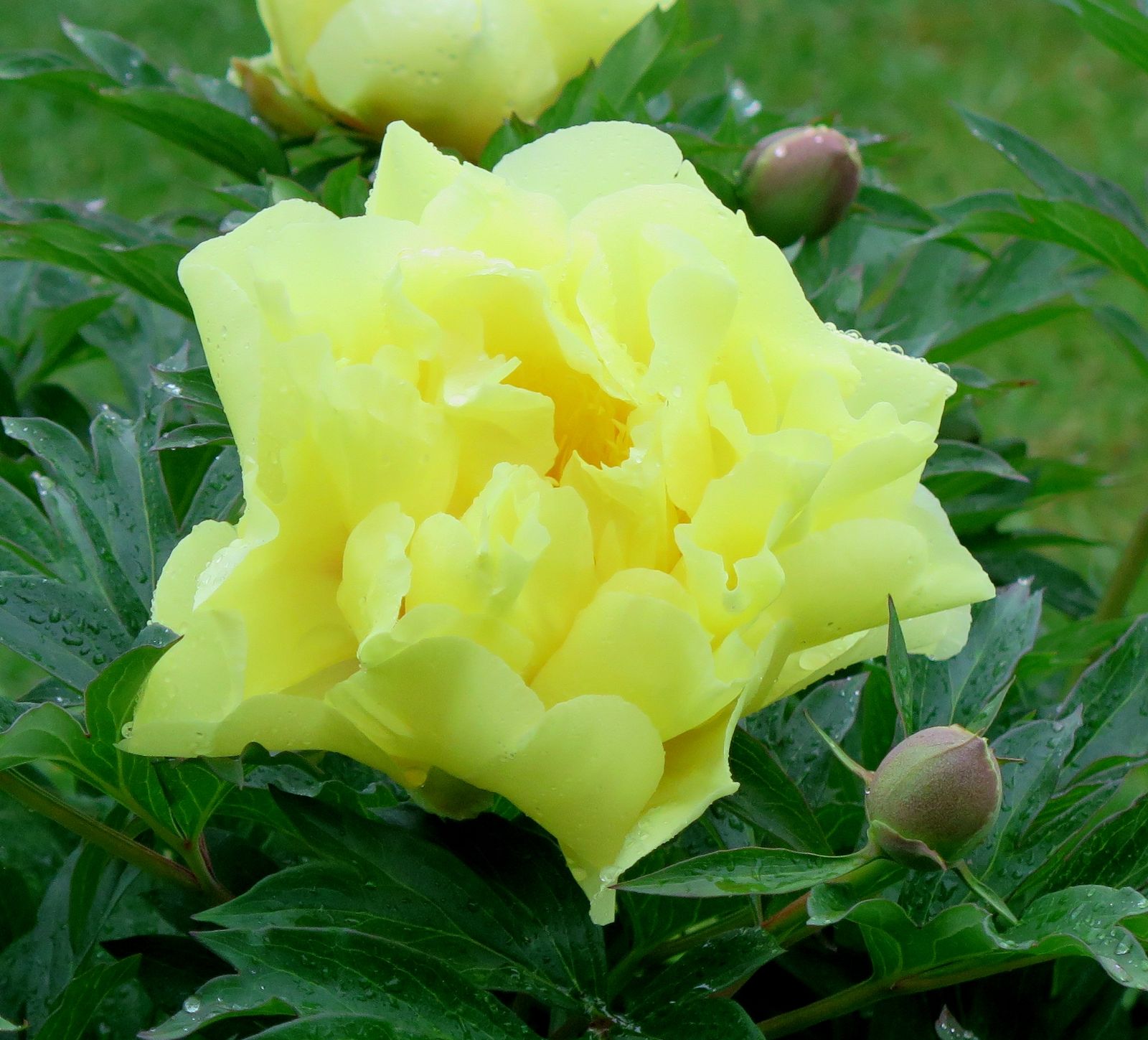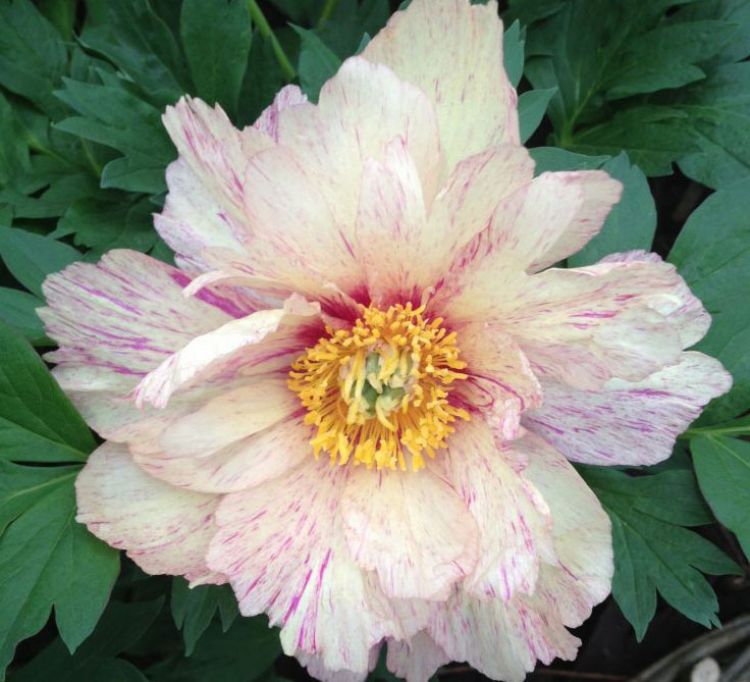Paeonia Itoh Cultivars
Sponsor
Kindly sponsored by
Sponsored by David Sayers in memory of Hedvika Fraser.
Credits
Julian Sutton (2020)
Recommended citation
Sutton, J. (2020), 'Paeonia Itoh Cultivars' from the website Trees and Shrubs Online (treesandshrubsonline.
Genus
Infraspecifics
Other taxa in genus
- Paeonia cathayana
- Paeonia Central Plains Cultivars
- Paeonia decomposita
- Paeonia delavayi
- Paeonia Gansu Cultivars
- Paeonia Japanese Cultivars
- Paeonia jishanensis
- Paeonia × lemoinei
- Paeonia ludlowii
- Paeonia Lutea Hybrids
- Paeonia ostii
- Paeonia Other Shrubby Hybrids
- Paeonia qiui
- Paeonia rockii
- Paeonia rotundiloba
- Paeonia Southern Yangtze Cultivars
- Paeonia Southwest Cultivars
- Paeonia × suffruticosa
Itoh cultivars are hybrids between herbaceous and woody peonies and are becoming a most important group in gardens. They are sub-shrubby to herbaceous, depending on variety and climate, and so fall at the margin of our scope in Trees and Shrubs Online. They are most valuable in winter-cold areas where truly woody peonies struggle, but even elsewhere their long blooming period and spectacular (some might say blowsy) flowers earn them garden space.
All Itohs, as defined by the American Peony Society, are hybrids between forms of the herbaceous P. lactiflora and woody peonies. In practice, the woody parents are hybrids of P. delavayi (Lutea Hybrids). A very few other intersectional hybrids exist, but are not in commerce, for example ‘Red Compass Rose’, whose parents were ‘Night Watch’ (a herbaceous hybrid of P. anomala) and woody P. delavayi (Buchite 2019).
These are not easy crosses to make. The first examples were produced by Tokyo grower Toichi Ito (alternatively Itoh) in the mid-20th century. A single successful cross, said to be from thousands (Klingaman 2011), produced several rather similar seedlings (Langhammer 2019), which flowered after Ito’s death; these were registered and distributed by the American Louis Smirnow from 1974 (see ‘Yellow Crown’ below). Ito’s successful cross was between P. lactiflora ‘Kakoden’ and Lemoine’s woody hybrid ‘Alice Harding’. Itoh hybrids are normally sterile triploids (Yang et al. 2020), and the many subsequent varieties result from repeated woody/herbaceous crosses; American hybrids of P. delavayi are the usual woody parents. A very few fertile Itoh hybrids have recently been identified, which may transform breeding (Yang et al. 2020). Among breeders, Don Smith of Connecticut and Roger Anderson of Wisconsin have been pre-eminent.
Hardy in USDA zones 4–9 (Cricket Hill Garden 2020), these are strongly growing plants, sending up annual shoots to a height of 60–120 cm, which are usually self-supporting. As in truly woody peonies, much of this dies back in winter. In cold areas such as the American Midwest, all aerial growth tends to be killed by frost, but underground buds survive without protection (Buchite 2019). In milder winters in southern England the basal 5–40 cm survives with live buds in some varieties (J. Sutton, pers. obs. 2020). Even then, some growers choose to remove some or all of these woody shoots on established plants, to avoid crowding the stronger basal growth (D. Joyce, pers. comm. 2018). Leaves are intermediate between the parents and tend to stay dark green and attractive after flowering for much longer than in herbaceous peonies. The flowers are generally large, to 20 cm diameter, and range from singles to very full semi-doubles. A terminal flower is usually followed by two from side buds, giving a flowering period of up to four weeks (American Peony Society 2020). Colours range from yellow, sometimes especially vibrant, to white, red, pink, lavender, peach and various bicolors (Smith 2019).
Itoh hybrids spread underground to form clumps, sometimes becoming wider than they are tall. Division in early autumn is straightforward on a small scale, and at first this was the main method of commercial propagation; prices were inevitably high. In the present century, tissue culture has become the leading method by which new cultivars come to market and older ones gain a wider distribution (Planteck 2020).
A representative selection of better known cultivars follows. For others, see American Peony Society (2020), Smith (2019), Burkhardt (2020).
'Bartzella'
Yellow with small red flares at the petal bases; a very full semi-double, with a light lemon-like fragrance. Vigorous and floriferous, approaching 1 m height and spread when well suited. Its parents were a double white P. lactiflora and an unnamed P. delavayi hybrid, A-198, raised by David Reath; bred by Roger Anderson, first flowered 1986 (American Peony Society 2020). Perhaps the most popular and widely distributed Itoh cultivar to date. The name derives from the Anderson family’s pastor, whose surname was Barts, with ‘ella’ added to soften the name (R. Anderson 2001, quoted by Burkhardt (2020)).
'Berry Garcia'
Cream, flushed and edged in pink, with large burgundy flares; semi-double, sometimes rather full, slightly fragrant. Height to 1 m when well suited. Its parents were P. lactiflora ‘Martha W.’ and unnamed P. delavayi hybrid A-198 raised by David Reath; bred by Don Smith, first flowered 2001 (American Peony Society 2020). The name is presumably a pun on the name Jerry Garcia, singer and guitarist with the Grateful Dead.
'First Arrival'
Lavender-pink, lightening with age; semi-double. Height 60–75 cm, making a rounded plant. Its parents were P. lactiflora ‘Martha W.’ and an unnamed P. delavayi hybrid raised by Reath; bred by Roger Anderson, first flowered 1984 (American Peony Society 2020; Burkhardt 2020).
'Lollipop'
Light yellow, flecked and streaked red-pink, sometimes very heavily; semi-double, sometimes rather full. Height about 70 cm. Bred by Roger Anderson, first flowered 1989, its herbaceous seed parent was one of Anderson’s own seedlings, the woody parent an unnamed P. delavayi hybrid, D-97, raised by Daphnis (American Peony Society 2020; Burkhardt 2020; Planteck 2020).
'Scarlet Heaven'
A red-flowered single, around 70 cm tall. Its parents were a seedling of P. lactiflora ‘Martha W’, and Saunders’ ‘Thunderbolt’; bred by Roger Anderson, first flowered 1989 (American Peony Society 2020; Burkhardt 2020; Planteck 2020).
'Sequestered Sunshine'
Yellow with red stigmas and sometimes small red flares at the petal bases; a long-stemmed single, sometimes semi-double. Height to 1 m. Its parents were P. lactiflora ‘Miss America’ and an unnamed P. delavayi hybrid, D-74, raised by Daphnis; bred by Roger Anderson, first flowered 1987 (American Peony Society 2020; Planteck 2020).
'Singing in the Rain'
Ground colour yellow, initially with a pink flush, appearing light orange at first, yellow later, differently aged flowers giving a two tone effect; semi-double, with a light fragrance. Vigorous and floriferous, potentially over 1 m tall. Its parents were P. lactiflora ‘Martha W.’ and ‘Golden Era’, a P. delavayi hybrid; bred by Don Smith, first flowered 2000 (American Peony Society 2020; Burkhardt 2020; Planteck 2020).
'Sonoma Amethyst'
Deep lavender, semi-double, height around 70 cm. Its parents were an unnamed P. lactiflora seedling and ‘Golden Era’; bred by Irene Tolomeo, California, registered 2001 (American Peony Society 2020; Warmerdam Paeonia 2020).
'Viking Full Moon'
Very pale creamy yellow with large, dull red flares; large flowers to 20 cm across, with about 10 petals in two whorls. Height to 1 m. Its parents were recorded only as P. lactiflora and yellow woody hybrid; raised by Roy Pehrson, United States, and registered by William Seidl after his death; first flowered about 1980 (American Peony Society 2020; Burkhardt 2020).
'White Emperor'
A white-flowered sport on ‘Yellow Emperor’ found by Bill Seidl, Wisconsin in 1977 (American Peony Society 2020). Truly white flowers are very rare among Itohs.
'Yellow Crown'
Semi-double yellow, with red flares. Height 60–100 cm, but usually towards the upper end. This variety is of historical interest as one of the original batch of Itoh hybrids, but has been largely superceded by cultivars such as ‘Bartzella’. Raised by Toichi Ito, Japan, in the mid-20th century, it first flowered in 1964, after his death, and was registered by Louis Smirnow in 1974. The parents were P. lactiflora ‘Kakoden’ and the woody hybrid ‘Alice Harding’ (American Peony Society 2020). It is still occasionally offered in the nursery trade. Three other seedlings from the same cross were registered at the same time. They are extremely similar, but the four can be distinguished as follows, based on plants grown together in Michigan (Langhammer 2019). ‘Yellow Crown’ is typically the tallest, more often reaching about 1 m, and has rounded, green buds. The others tend to be shorter, with mostly red-tinted sepals in bud: ‘Yellow Emperor’ has elongated flower buds, which remain pointed until the flowers open; ‘Yellow Heaven’ differs in its buds becoming rounded as it approaches anthesis, while ‘Yellow Dream’ has rounded buds throughout.








